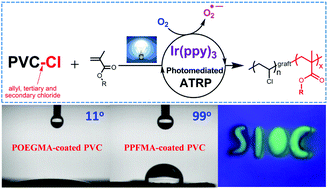Direct functionalization of poly(vinyl chloride) by photo-mediated ATRP without a deoxygenation procedure†
Abstract
A facile strategy of Ir-catalyzed visible light mediated atom transfer radical polymerization (ATRP) was reported toward direct modification of commercial poly(vinyl chloride) (PVC) by graft polymerization of methacrylate monomers, such as methyl methacrylate (MMA), pentafluorophenyl methacrylate (PFMA), and oligo(ethylene glycol) methyl ether methacrylate (OEGMA). This approach also allows (co)polymerization of acidic monomers of methacrylic acid (MAA), which is usually incompatible with conventional ATRP. In this approach, the structural defects of allyl chloride and tertiary chloride groups of PVC, along with some of the secondary chlorides of vinyl chloride repeated units, were activated to serve as initiating sites for photo-mediated ATRP by using Ir(ppy)3 as a photo-redox catalyst under low intensity blue LED light strips (10 W, 460–470 nm) in DMF, probably preserving secondary C–Cl bonds of VC repeated units. The polymerization can be effectively tuned between “activation” and “deactivation” states by alternating light “ON” and “OFF” with the maintenance of a linear increase in molecular weight with conversion and first order kinetics. Most importantly, this kind of polymerization shows great tolerance with oxygen, which can proceed in a closed vessel with a controlled/living manner without a deoxygenation procedure. Additionally, this strategy can be employed for the surface functionalization of commercial PVC sheets by surface-initiated ATRP of methacrylate monomers, i.e. PFMA and OEGMA, without prerequisite of functionality transformation and deoxygenation procedures. The surface water contact angles of the PVC sheet changed from 74° to 11° and above 92° after surface functionalization with POEGMA and PPFMA, respectively. Due to the spatially controlled ability of this strategy, the selective regulation in location and density of the surface functionalization of PVC, that is, surface patterning can be realized by modulating the dosage of light.


 Please wait while we load your content...
Please wait while we load your content...